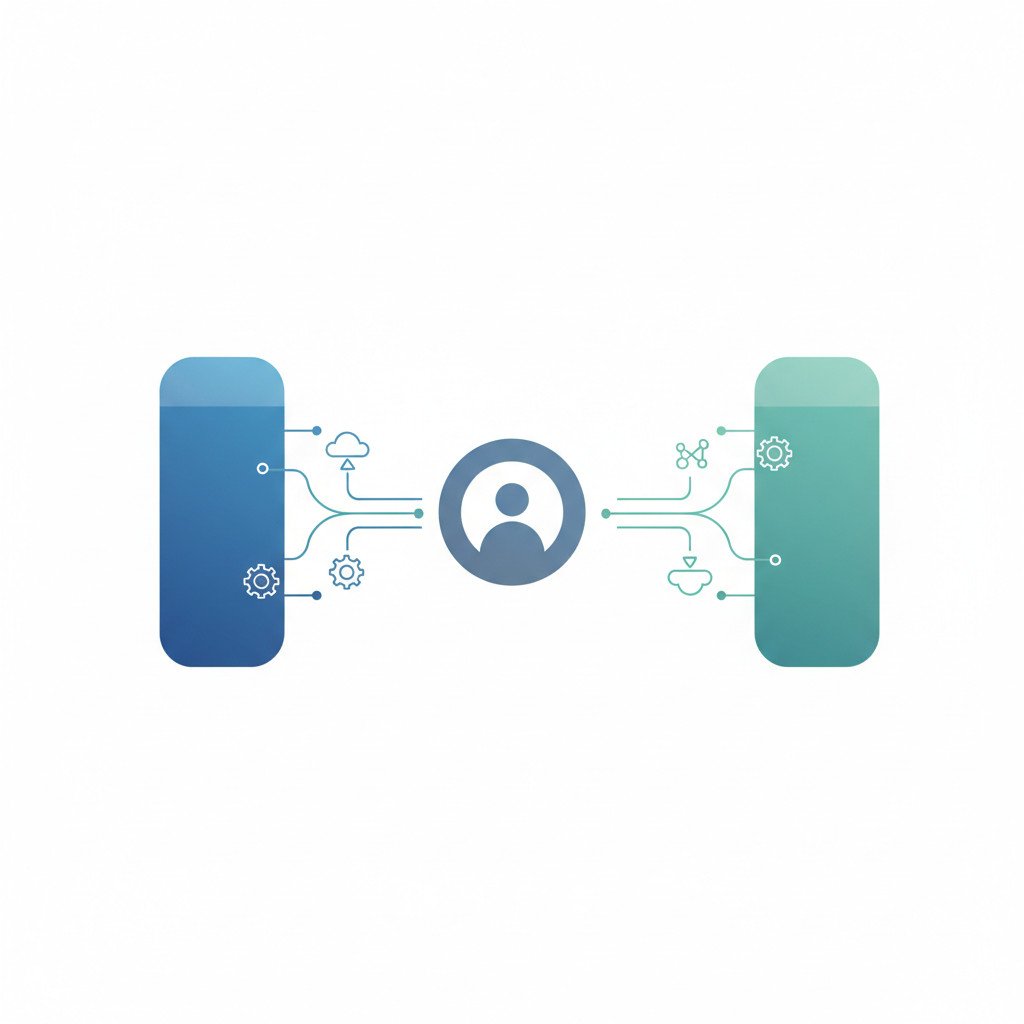Zapier vs Gumloop
Zapier vs Gumloop is the question many teams face when choosing a no-code automation platform.
Because automation drives efficiency and scale, this choice affects time, costs, and growth.
On one side, Zapier brings a battle-tested ecosystem with 8,000 plus integrations, enterprise-grade security and compliance, task-based pricing, and mature admin controls; on the other side, Gumloop, founded in 2023, offers an AI-first approach with AI-powered nodes, LLM workflows, image and video analysis, credit-based pricing, and flexible custom integrations to support creative builders, intelligent data extraction, and specialized use cases such as forms, portals, and CRM automation.
Therefore, this comparison will evaluate:
- Integration breadth
- Reliability and uptime
- Security and governance
- AI capabilities and model integrations
- Developer extensibility and SDKs
- Pricing predictability versus credit models
- Onboarding and ease of use
- The real work of building automated workflows
So that product leaders, IT teams, and operations managers can choose the right tool for scale, cost control, and innovation.
Read on to see which tool best fits your team’s automation strategy.
Zapier vs Gumloop: Understanding Zapier
Zapier connects apps and automates workflows without code. Therefore teams automate repetitive tasks and save time. As an integration platform, Zapier links more than 8,000 apps. Because of this scale, it suits businesses of all sizes.
What Zapier is
Zapier is a no code automation platform that moves data between tools. It acts as a bridge between apps like Gmail, Slack, and Asana. As a result, users build automation workflows with simple triggers and actions. Zapier also offers AI helpers such as Zapier Copilot to speed automation creation.
Core features
- Integration library with 8,000 plus apps and growing. This breadth reduces custom coding needs.
- Visual workflow builder that uses triggers and actions for quick setup. Therefore non technical users can start fast.
- Advanced features like multi step workflows, conditional logic, and looping for complex flows.
- Enterprise controls including single sign on, granular permissions, and audit logs for governance.
- Security and compliance covering SOC 2, GDPR, and CCPA to protect data.
- Task based pricing that keeps costs predictable for many teams.
Common use cases
- Lead routing from forms into CRM with immediate follow up messages. This speeds sales cycles.
- Customer support automation that posts tickets into help desks and notifies teams.
- Marketing operations such as campaign reporting, list syncing, and social publishing.
- Finance and operations automations for invoicing, expense tracking, and reconciliations.
User benefits and productivity gains
- Faster onboarding for non technical teams because setup stays visual and guided.
- Reduced manual work leads to fewer errors and more consistent processes.
- Scalable reliability with 99.99 percent uptime for mission critical automations.
- Broad partner ecosystem that supports integrations with enterprise vendors and niche tools.
Where to learn more
For a platform level comparison, see this deep dive on Articles Emp0. For AI workflow specifics, read the AI first comparison on Articles Emp0. To explore Zapier integrations, visit Zapier apps.
Related keywords: automation workflows, productivity tool, integration platform, AI automation, Zapier Copilot, Zapier Agents.

Zapier vs Gumloop: Understanding Gumloop
Gumloop is a modern AI-first automation platform designed for builders and teams. It launched in 2023 and focuses on combining AI with no-code workflow tools. Because it centers on machine learning, Gumloop offers nodes that extract data, analyze images and video, and call large language models. As a result, teams can build automations that involve unstructured inputs.
Unique features
- AI-powered nodes for data extraction, sentiment analysis, and media understanding.
- LLM integrations that let automations generate text, summarize content, and transform data.
- Credit-based pricing that maps cost to automation complexity, especially for AI workloads.
- Visual flow builder optimized for model orchestration and branching logic.
- Native support for forms, portals, and CRM connectors such as Slack, Asana, Typeform, and Pipedrive.
- SDKs and custom integration options to add niche apps quickly.
Key functionalities
Gumloop supports multi step workflows with conditional logic. It also handles file and media processing. The platform includes connectors for popular business apps. Developers can extend functionality through code nodes. Designers can prototype flows fast because of reusable components. The focus on AI means tasks like OCR and image tagging run inside workflows.
Advantages over competitors
Gumloop stands out when projects require AI automation. It provides specialized nodes for image and video analysis. Furthermore, teams can embed LLMs without building custom pipelines. For startups and product teams, the credit model can make costs more predictable. In addition, the platform emphasizes rapid iteration and self service building. However, Gumloop’s integration library is smaller than legacy competitors. Therefore custom connectors are sometimes required for niche tools.
Use cases
- Automated content review and moderation pipelines.
- Intelligent lead enrichment from images and documents.
- Media analysis for marketing and creative teams.
- Internal tooling powered by LLM prompts and data extraction.
For a detailed head to head comparison, see this analysis on Which platform wins: Zapier vs Gumloop comparison for scalable automation?. For perspectives on AI-first workflows, read Zapier vs Gumloop: Which AI-first automation platform is best for enterprise-scale workflows?.
Related keywords: business automation, workflow tools, automation platform, AI automation, Gummie, custom integrations.
Comparison at a glance
Therefore use this quick comparison to evaluate both platforms across common decision criteria.
| Feature | Zapier | Gumloop |
|---|---|---|
| Pricing | Task based pricing; predictable costs for automations and scale | Credit based pricing; maps to AI complexity; credits range from 1 to 60 |
| Ease of use | Visual builder; low learning curve for non technical users; Zapier Copilot speeds setup | Visual flow builder but more AI concepts; slightly steeper learning curve for newcomers |
| Integrations | 8,000 plus native integrations covering enterprise and niche apps | Around 100 native integrations with focused apps; custom connectors available |
| Customizability | Supports custom code steps and webhooks; wide community templates | Code nodes and SDKs enable deep customization and model orchestration |
| Customer support | Enterprise plans include priority support and admin tools; large knowledge base | Active product support for builders; responsive but smaller support team |
| Security features | SOC 2, GDPR, CCPA, SSO, audit logs, granular permissions | Platform security improving; enterprise grade features vary by plan |
| Ideal business size | Startups to large enterprises; proven at scale | Startups and product teams focused on AI workflows; growing into mid market |
Related keywords: automation workflows, business automation, workflow tools, integration platform.

Integration Capabilities of Zapier vs Gumloop
Integration drives automation success because workflows depend on reliable data flow. Therefore choosing a platform with the right connectors matters for scale and agility. Below we compare native integrations, third party support, and the practical ease of connecting systems.
Native integration breadth
- Zapier: Zapier offers over 8,000 native integrations. As a result, teams rarely build custom connectors. This breadth covers enterprise apps, CRMs, marketing tools, and niche SaaS. Moreover Zapier maintains templates and community integrations for quick starts.
- Gumloop: Gumloop provides around 100 native connectors focused on popular business apps. Because it is newer, its library covers core tools like Slack, Asana, Typeform, and Pipedrive. However you may need custom connectors for niche systems.
Third party and custom support
- Zapier: Zapier supports webhooks, API calls, and custom code steps. Therefore developers can extend flows to almost any system. Zapier also supports community built integrations and developer apps for custom onboarding.
- Gumloop: Gumloop includes SDKs and code nodes for deep customization. Additionally it enables custom connectors and model orchestration within flows. This approach suits AI intensive integrations that require media processing or LLM calls.
Ease of connecting multiple systems
- Zapier: The visual builder uses triggers and actions, making multi app orchestrations straightforward. Because Zapier has proven templates, teams achieve results quickly. Reliability remains high with mature retry and error handling.
- Gumloop: Gumloop excels when workflows include AI nodes, media extraction, or LLM steps. However building sophisticated flows may require more product knowledge. Therefore teams that need model orchestration will value Gumloop.
Key takeaways
- If you need maximum app coverage and predictable connections, choose Zapier. It reduces integration work and speeds deployment.
- If you require AI first workflows with media and LLM integrations, choose Gumloop. It lets you embed models directly into pipelines.
For reference explore Zapier’s full app directory.
Customer Support and User Experience in Zapier vs Gumloop
Good support and a friendly user interface determine how quickly teams ship automations. Therefore this section compares support channels, responsiveness, community resources, and UX for both platforms.
Support channels and tiers
- Zapier
- Email and ticket support across plans, with priority and dedicated support on enterprise tiers. Because enterprise customers need faster SLAs, Zapier offers account teams and onboarding assistance.
- Large knowledge base, tutorials, community forum, and template library for self service.
- Gumloop
- Product support focused on builders and teams, with direct support channels for paying customers. Additionally, Gumloop emphasizes hands-on help for AI workflows.
- Documentation and SDK guides are emerging, and support often involves technical triage for complex nodes.
Responsiveness and quality
- Zapier responds quickly for enterprise plans. As a result, many teams report fast resolution for critical incidents.
- Gumloop typically offers responsive product support. However, response times vary as the company scales support capacity.
Community and resource availability
- Zapier has a broad user community, abundant tutorials, and many third-party blog posts. Therefore, users find solutions from peers fast.
- Gumloop has a smaller but active developer community. Moreover, specialized examples for AI nodes and model orchestration are available from product docs and early adopters.
User interface and onboarding
- Zapier: The interface uses a visual builder, templates, and step-by-step prompts. Many users say, “Zapier is the easiest automation tool to use, especially for non-technical users.” This ease helps product teams and business users onboard quickly.
- Gumloop: The interface focuses on model orchestration and media nodes. Consequently, the learning curve can be steeper. One internal note captures this: “The learning curve of the product is too steep. If we can make that first 20 minutes less confusing, we will solve 80 percent of the problem.”
Key UX insights
- For non-technical teams wanting predictable, rapid onboarding, Zapier provides the smoother experience.
- For teams building AI-first automations, Gumloop offers deeper capabilities. However, onboarding may need more technical support and training.
In short, Zapier prioritizes discoverability and broad self-service. Gumloop prioritizes AI functionality and technical depth. Therefore, choose based on your team’s skill mix and support needs.
Pricing and Value Proposition of Zapier and Gumloop
Pricing shapes the ROI of automation because it affects running costs over time. Therefore teams must weigh cost predictability against advanced capabilities. Below we compare pricing models, free tiers, and value for different business sizes.
Pricing models explained
- Zapier: Zapier uses task based pricing. This model charges per automation run. As a result costs stay predictable for high volume, routine automations. Zapier also provides a free tier and several paid tiers to scale usage.
- Gumloop: Gumloop uses a credit based pricing model. Credits map to automation complexity and AI compute. For example basic operations cost fewer credits while heavy model or media tasks cost more. Therefore costs can vary as AI usage grows.
Free tiers and trials
- Zapier: Zapier offers a free plan for basic testing and small workflows. Thus teams can prototype automations before buying.
- Gumloop: Gumloop typically provides trial access and starter plans for evaluation. However charges accrue as you run AI nodes that consume credits.
Value by business size
- Startups and small teams: Gumloop delivers strong value when your product needs AI first features. Because you can run model orchestration quickly, teams build prototypes fast. However watch credit consumption closely.
- Small and mid market: Both tools fit depending on needs. Zapier works well for cross tool syncing and repetitive tasks. Meanwhile Gumloop adds value when media or LLM steps matter.
- Enterprise: Zapier often wins on cost predictability, governance, and integration breadth. Moreover Zapier’s enterprise features and uptime support critical workloads.
Pros and cons summary
-
Zapier pros: predictable task based billing, broad integrations, enterprise controls.
Cons: AI heavy workflows may need external orchestration. -
Gumloop pros: flexible credit model for AI workloads, powerful AI nodes, media processing.
Cons: credits can complicate forecasting and integrations are fewer.
Cost effectiveness insights
If you run predictable, high volume automations, Zapier usually offers clearer cost forecasting. Conversely if your workflows rely on heavy AI tasks, Gumloop can reduce development time and add business value despite variable costs. Therefore choose the model that matches your automation profile and growth plans.
Conclusion
Choosing between Zapier and Gumloop depends on priorities and scale. Zapier excels with proven reliability, a massive integration library, enterprise governance, and predictable task based pricing. Therefore teams that need broad app coverage and predictable costs will favor Zapier.
However Gumloop brings an AI first approach. It enables media analysis, LLM orchestration, and specialized nodes for data extraction. As a result Gumloop suits teams that prioritize intelligent automation and rapid model experimentation. Yet Gumloop’s integration library is smaller, so custom connectors are sometimes needed.
In practice evaluate three factors before deciding: the apps you must connect, the complexity of AI workloads, and your forecasted usage patterns. Because integration breadth affects speed to value, Zapier often reduces integration overhead. Conversely if your workflows depend on image, video, or LLM tasks, Gumloop can shorten development time and add direct AI value.
For companies seeking a comprehensive automation partner, Employee Number Zero LLC provides end to end AI and automation solutions. EMP0 builds sales and marketing automation tools and acts as a full AI worker and growth system provider. Moreover EMP0 helps teams design automation strategies, deploy AI workers, and maintain operational governance. Therefore businesses gain both tooling and operational know how.
To explore EMP0 visit Employee Number Zero and browse practical guides on the EMP0 blog at EMP0 blog. Additionally follow the team on Twitter/X @Emp0_com for updates and case studies. Finally pick the platform that fits your workload and team skills, and then layer on services like EMP0 for faster, safer adoption of automation.

